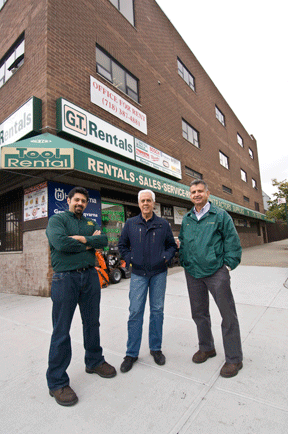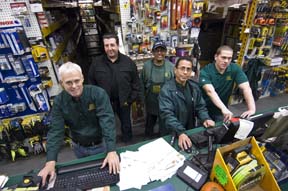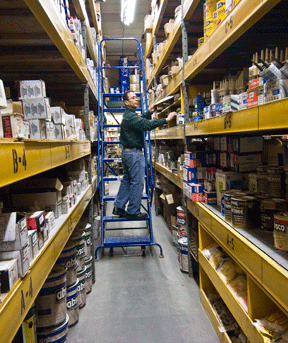Step by step
G.T. Rentals builds solid foundation
By David Wolff
 Score another victory for the American Dream. The story of George Georgakis is another successful chapter in this long running saga.
Score another victory for the American Dream. The story of George Georgakis is another successful chapter in this long running saga.
Georgakis is the founder of G.T. Rentals, an independent rental store in Brooklyn, N.Y. In 1971, when he was 27, Georgakis came to the United States from Greece to build his future. At first, he spoke only his native language. He studied English, earned a degree in engineering and started a construction company specializing in waterproofing and restoration projects. In 1992 he opened a rental store to support this business. Today, G.T. Rentals is run by his son, Jack Georgakis, and operates from a 30,000-square-foot facility with 12 employees and more than 5,000
customers. The construction company has 20 employees and works on multiple projects in New York City’s five boroughs.
The elder Georgakis lists four basic tenets for running a successful rental business:
- The owners must be deeply involved. This means long hours and a thorough knowledge of every aspect of the business.
- Customer satisfaction. Make them want to be your customer for life.
- Loyal employees. Fair compensation, health and retirement benefits and good training keep turnover low.
- Lines of credit must be carefully scrutinized. As George says, “No deal is better than a bad deal.”
G.T. Rentals offers a full product line, but does not carry a wide range of large equipment because of storage and trucking space limitations in the dense metropolitan area. Their primary customers are medium-sized contractors who need equipment right away.
Solutions center
“The rental business has gotten more and more demanding, maybe because there are more new contractors,” Jack says. “We have a lot of customers because we’re a solutions center. Rarely does someone come in and say they need to rent a lift. Instead, it’s ‘I have something that weighs 4,000 pounds that has to be put on the back of a truck.’ It seems the services we provide are more solutions-based as opposed to just equipment leasing.”
To accomplish this challenge, George leads by example. He grew G.T. Rentals by spending 12-hour days, seven days a week learning each job and what equipment works best. He passed on that knowledge to Jack, who communicates everything he knows to the staff. It’s important that every staff member gets a taste of each aspect of the business. A counter person will sometimes load equipment, and a mechanic will spend time at the counter.
“We’re big on sharing knowledge, whether it’s the point-of-sale system or machine specifications,” Jack says. “When you stay too long in a certain area, you tend not to understand the role of others and your place in the bigger picture. I think the way we do it generates more of a team feeling. Instead of complaining because you weren’t called about an equipment pickup, you might realize that the counter is busy and that’s why you weren’t called. Sharing knowledge builds a level of trust because everybody knows what’s going on. Most everyone has been here a number of years, and I’m proud of that. It’s important to appreciate that people are different. Some are customer service oriented, while others are more mechanical.”
Sales vs. rental
Offering customers the opportunity to try out equipment has boosted G.T. Rentals’ equipment sales and rental ratio to about 50/50. If someone takes out equipment for a day and then buys, the rental fee is waived. “Times are tight,” Jack says, “and if we can take that worry away from customers, it’s priceless.”
According to Jack, customers tend to look at buying versus renting as a straight cost. If a rental costs $5,000 for six months and the purchase price is close to that amount, they will buy. The only time they will deviate from this equation is when equipment is hard to resell.
“For example,” Jack says, “it’s hard to get rid of a tow-behind compressor, boom or skid steer, so customers are more likely to rent these items. On smaller equipment such as air compressors or nail guns, the tendency for them is to buy.”
 |
| The counter staff includes, from left, Gordon McClean, Adam Jones, Keith Sankar, Carlos Rosado and Brian Rosado. |
Another element in the rental equation is inventory. It represents a cost, and excess equipment must be reflected in rental prices.
“We compare our prices with competitors,” Jack says, “although we really don’t care what they do. We have to charge what makes sense for us. Maybe a 15 percent markup is enough for us to be profitable; we don’t have to go to 40 or 50 percent. We haven’t raised our rental prices in almost four years. We prefer to make our money through volume. We strive to keep customers happy with low pricing and make up the difference in volume.”
General manager Gus Eleftheriadis came to G.T. Rentals following a 14-year career as a banking executive. One of his first moves was to organize the inventory tracking system. More than 7,000 items were coded and tracked for their rental readiness.
“If we’re not organized, we are going to fail,” he says. “Organization is the cornerstone of success. In order to grow, we need to be different from our competitors. This means we have to have the proper equipment, make sure it’s reliable and deliver it as quickly as possible. If we don’t do that, the customer will go somewhere else where he doesn’t have to wait a half an hour. Satisfied customers keep coming back, and that builds growth.”
Credit crunch
Credit is the double-edged sword of customer satisfaction and growth. George and Jack Georgakis and their former banker associate Eleftheriadis have industry longevity and financial savvy on their side. As a result, they have established these hard and fast rules:
- Determine a customer’s credit character. Conduct credit background checks whenever possible.
- Extend credit conservatively. Run a six-month trial and adjust accordingly. Don’t lend large amounts. How much can G.T. Rentals support? If asked for $25,000, maybe $15,000 makes more sense.
- Use good relationship management. “Sometimes we just have to take a stand,” Jack says. “We’ve had good customers walk out because we didn’t extend them the credit they wanted, but then they came back a couple months later. I don’t want to be a bully, but we have to stand up if we’re going to stay in business and be profitable.”
According to Jack, there are two reasons why contractors rent – because they want to, or they have no choice.
“Sometimes the best rental customer is not a good opportunity for us,” he explains. “We’ve been burned a couple of times, and it’s a hard lesson to learn. It’s a sad fact, but some rental customers just can’t afford to buy equipment, especially items that can be easily damaged. This always leads to a problem. We never want to be abrasive and lose a customer, but at the same time we don’t want to get stepped on. It’s a fine balance.” Controlled growth
Controlled growth
George offers his opinion on G.T. Rentals’ growth strategy. He says that as New York City becomes increasingly condensed and traffic gets even more congested, the business has to be more in touch with the rental needs in its back yard.
“The world got smaller, but locally it got bigger,” he explains. “It’s a strange thing. When I look at our revenue, I look at where it is coming from. When one building is finished, another project is started, and the rotation repeats. New York is what’s called a ‘freeze over’ state, and this creates constant repair situations. Broken expansion joints cause leaks and building inspections are ongoing, which leads to more work and consequently more rental opportunities.”
Jack, reflecting the second generation’s more formal, analytical approach, points to available capital as a critical growth issue.
“Equipment costs a lot of money,” he says. “The return on investment might be there, but it takes time to accrue. The situation was worse when we were smaller and didn’t have as much capital, but today it’s better. We have to use some self-control when we decide which markets to get into. If the return on an aerial work platform is a few years, plus maintenance, it’s an issue. Because of space considerations and capital, we don’t want to go into big steel or aerial equipment. Also, we can’t compete with outfits on the edge of the city who pay one-third of the rent and taxes we do, plus have a lot more space to store and repair equipment. We keep a fleet of smaller equipment that customers pick up and return in one day. The rental fleets outside the city with larger equipment don’t want to come to our area. They can’t get a pickup after noon.”
Eleftheriadis takes a position on growth near the midpoint of father and son.
“If we’re being asked quite a bit about a machine we don’t have, maybe it’s time to get one,” he says. “The more machines we have, the more diverse we become and the more reliable we are for the customer. We have a good name because we’re a reliable source, and contractors remember us. We had to earn it. The biggest compliment is when a competitor or customer says go to G.T. Rentals, they’ll have it.”
Originally published in the January/February 2014 issue of Pro Contractor Rentals. Copyright 2014 Direct Business Media; Copyright now Urbain Communications 2019.








